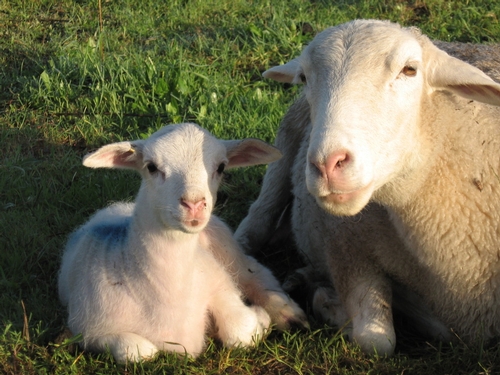More Risky Business
If you’ve been reading our “Farming in the Foothills” blog over the last year, you’ll know that commercial farming is inherently risky profession. My fellow farmer Molly Nakahara (of Dinner Bell Farm) did a great job of describing farming risk in her October 28 post, “Farming, the Original Risky Business.” We farmers and ranchers face numerous uncertainties – from the weather to the marketplace to the regulatory environment. Some of these risks are short-term – like the snow storm that cancelled last weekend’s farmers’ market in Auburn. Some are long-term – like the potential impacts of new federal food safety standards on direct-market growers. Some risks can be eliminated, while others can only be mitigated. Our success as farmers and ranchers, in large part, depends on our success in managing these risks.
As a sheep rancher, there are two weather-related risks that foremost in my mind at the moment – one short-term and one long-term. As we wrap up our fall lambing season, we are in the midst of our regular early December cold snap. While the first week of December usually brings some of the coldest temperatures of the year, this year’s cold snap is especially severe and protracted. Since December 4 in Auburn, our morning lows have been in the teens, and our daytime highs have been in the high thirties or very low forties. At McCormack Ranch in Rio Vista, where we are lambing, the temperatures haven’t been much warmer. The cold weather presents a number of challenges: lambs that aren’t getting enough mother’s milk can quickly succumb to hypothermia. Lactating ewes that aren’t getting enough drinking water won’t produce as much milk. The sheep have to consume more feed just to maintain body temperature (let alone produce milk), so their feed demand increases.
From a longer-term perspective, we appear to be in the midst of a protracted drought. While we had a bit of rain in September, this fall has been dryer than normal. We finally got a germinating rainfall in mid-November – just in time for the weather to turn cold and the grass to go dormant. As a grass-farmer, I depend on fall grass growth to get our sheep through the winter months – and this year we didn’t get much growth. As we look toward next year, I’m very concerned that we may not have enough irrigation water to carry us through the summer months. The Nevada Irrigation District (NID) recently reported that we just experienced the driest January-November period in the district’s history – just over 20 inches of precipitation fell in NID’s upper watershed in the past 11 months. Unless we catch up soon, we may be facing reduced water deliveries next summer.
Obviously, these challenges can make for depressing conversations with other farmers, but there are some strategies we can use to mitigate (rather than eliminate) these risks. The weather is beyond our control, but our response to these conditions is not. Here are a few of the things we’re doing to manage these risks:
Short-term – sub-freezing temperatures
- As soon as we saw the forecast for sub-freezing temperatures, we moved the ewes who had not lambed into more sheltered paddocks. Lambs and ewes can deal with cold temperatures as long as they can avoid windy and wet conditions. These paddocks also had plentiful forage, which ensured sufficient feed intake for lactation and body temperature maintenance.
- We wrapped all of the pipes on the ranch to reduce the possibility of breakage (and subsequent time-consuming repairs). We also placed extra troughs in each paddock that we could reach with a hose from the water truck – if the permanent troughs froze, we could at least fill the temporary troughs from the truck.
- We moved the ewes with older lambs into the hills and increased the amount of hay we were feeding – again, to maintain milk production.
Long-term – drought
- We usually plan on culling 10-15 percent of our older ewes and replacing them with ewe lambs. We’ve been expanding our flock over the last several years, which means we cull fewer ewes and keep more ewe lambs. This year, we’ll consider culling more deeply – perhaps 20-25 percent of our ewes will be sold once we’ve weaned their lambs. We’ll also only keep ewe lambs out of our best and most productive ewes. While this will reduce our sheep inventory in the short-term, it will improve the overall productivity of our flock (measured in terms of lambing rate and pounds of lamb raised per ewe) over the long-term. Drought, then, allows us to improve the genetics of our flock.
- We’ll once again limit the number of lambs that we’ll keep to finish on grass and market directly to customers. As in 2013, we’ll base our decision on the amount of high quality summer forage likely to be available to us.
- We’ll evaluate the potential to invest in more efficient irrigation technology, like pod sprinklers. If we can make our irrigation water go further, we can grow more forage.
- Finally, we’ll also look for opportunities to graze alternative forages. This year, we’ve grazed crop residues and green “weedy” forage at Amber Oaks Farm in Auburn. We’ve also grazed alfalfa stubble in Rio Vista. Grazing helps to manage pests (plants and insects) on these operations while providing our sheep with higher quality forage.
Even with a risk management plan, these are the types of things that keep farmers and ranchers awake at night. While rain and wind never fail to awaken me from deep sleep, they keep me awake all night if they come in the midst of lambing. That said, a systematic approach to considering risk and adjusting to real-world conditions is critical to a successful farming or ranching operation. Ultimately, risk is just one of the many reasons that Tom Cruise isn’t a farmer.


